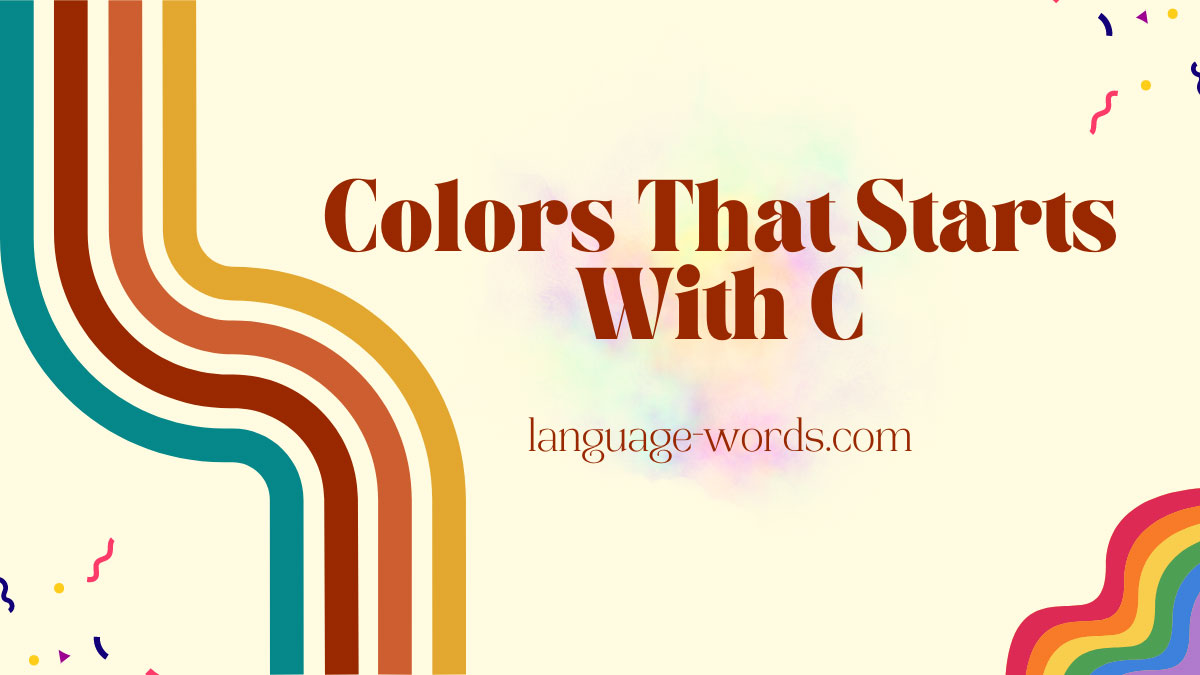Hey there! Are you ready to dive into the world of colors that start with the letter “C”? Well, buckle up because we’re about to embark on a vibrant journey filled with captivating hues and fascinating shades. From the calming blues to the fiery reds, the color spectrum is vast and diverse. But today, we’ll be focusing on those special colors that begin with the letter “C”. So, get ready to explore a kaleidoscope of colors that will surely leave you inspired and amazed!
When it comes to colors that start with “C”, there are some absolute stunners that deserve our attention. From the classic elegance of “Crimson” to the fresh and invigorating “Chartreuse”, these colors have the power to evoke emotions and set the mood in any setting. Whether you’re an artist looking for inspiration or simply someone who appreciates the beauty of colors, this article will introduce you to a whole new world of shades that start with the letter “C”. So, let’s get started and discover the enchanting colors that await us!

List Of Colors That Starts With C
| Cab Sav | Cabala | Cabaret | Cabernet |
| Cabinet | Cactus | Cadet | Cadet Blue |
| Cadet Gray | Cadet Grey | Cadillac | Cadmium Green |
| Cadmium Orange | Cadmium Red | Cadmium Yellow | Café Au Lait |
| Cafe Noir | Café Noir | Cafe Royale |
Calcium Carbonate
|
| Calico | Calico Red | California | Calypso |
| Camarone | Cambridge Blue | Camel | Camelot |
| Cameo | Cameo Pink | Camouflage |
Camouflage Green
|
| Can Can | Canary | Canary Yellow | Candle Light |
| Candy Apple Red | Candy Pink | Cannon Black | Cannon Pink |
| Canyon Orange | Cape Cod | Cape Honey | Cape Palliser |
| Caper | Cappuccino | Capri | Caput Mortuum |
| Caramel | Caramel Brown | Cararra | Carbon |
| Cardin Green | Cardinal | Cardinal Pink | Careys Pink |
| Caribbean Green | Carissma | Carla | Carmine |
| Carnaby Tan | Carnation | Carnation Pink | Carnelian |
| Carolina | Carolina Blue | Carousel Pink | Carrot |
| Carrot Orange | Casablanca | Casal | Cascade |
| Cashew | Cashmere | Casper | Cassel Earth |
| Castleton Green | Catalina Blue | Catawba | Catskill White |
| Cavern Pink | Cedar | Cedar Brown | Cedar Chest |
| Ceil | Celadon | Celery | Celeste |
| Celestial Blue | Cello | Celtic | Celtic Blue |
| Cement | Ceramic | Cerise | Cerise Pink |
| Cerulean | Cerulean Blue | Cerulean Frost | Cg Blue |

| Cg Red | Chablis | Chalet Green | Chalky |
| Chambray | Chamois | Chamoisee | Champagne |
| Champagne Pink | Chantilly | Chapel Rose | Charade |
| Charcoal | Chardonnay | Charleston Green | Charlotte |
| Charm | Charm Pink | Chartreuse |
Chartreuse Yellow
|
| Chathams Blue | Cheese | Chelsea Gem | Chenin |
| Cherokee | Cherry | Cherry Blossom Pink | Cherrywood |
| Cherub | Chestnut | Chicago | Chiffon |
| Chilean Fire | Chilean Heath | Chilean Pink | Chili |
| Chili Red | China Ivory | China Pink | Chinese Red |
| Chinese Violet | Chinese Yellow | Chino | Chinook |
| Chipmunk | Chlorophyll Green | Chocolate | Christalle |
| Christi | Christine | Chrome White | Chrome Yellow |
| Chromium Green | Cinder | Cinderella | Cinereous |
| Cinnabar | Cinnamon | Cinnamon Satin | Cioccolato |
| Citrine | Citron | Citrus | Clairvoyant |
| Clam Shell | Claret | Classic Rose |
Classic Rose Pink
|
| Clay Ash | Clay Creek | Clear Day | Clementine |
| Clinker | Cloud | Cloud Burst | Cloudy |
| Clover | Cobalt | Cobalt Green | Cochineal |
| Cocoa Bean | Coconut | Coconut Cream | Coconut Shell |
| Cod Gray | Coffee | Coffee Bean | Cognac |
| Cola | Cold Purple | Cold Turkey | Colonial Green |
| Colonial White | Columbia | Columbia Blue | Comet |
| Como | Compose Blue | Conch | Concord |
| Concrete | Confetti | Congo Brown | Congo Pink |
| Congress Blue | Conifer | Contessa | Cool Grey |
| Cool White | Copper | Copper Canyon | Copper Penny |
| Copper Red | Copper Rose | Copperfield | Coquelicot |
| Coral | Coral Pink | Coral Red | Cordovan |
| Corduroy | Coriander | Cork | Corn |
| Corn Harvest | Cornfield | Cornflower | Cornflower Blue |
| Cornsilk | Corvette | Cosmic | Cosmic Cobalt |
| Cosmic Latte | Cosmos | Costa Del Sol | Cotton Candy |
| Cotton Seed | Cottonwood | Country Blue | Country Red |
| Covenant | Cowboy | Coyote Brown | Crail |
| Cranberry | Cranberry Wine | Crater Brown | Cream |
| Cream Can | Cream Yellow | Creeper Green | Creme Brulee |
| Creole | Crete | Crimson | Crocodile |
| Crocus Yellow | Crown Of Thorns | Crowshead | Crude Oil |
| Cruise | Crusoe | Crusta | Cultured Pearl |
| Cumin | Cumulus | Cupid | Curious Blue |
| Currant | Curry | Cutty Sark | Cyan |
| Cyber Grape | Cyber Yellow | Cyclamen | Cyprus |
| Cyprus Green |
Crimson: A Timeless Classic
Crimson is a color that has stood the test of time, captivating people for centuries with its rich and bold hue. As an artist, I find myself continually drawn to the depth and elegance that crimson brings to a painting or a piece of artwork. This vibrant shade of red exudes a sense of power and passion, making it a timeless classic in the world of colors.
One of the fascinating aspects of crimson is its historical significance. Throughout history, crimson has been associated with royalty, wealth, and power. It was often used in royal garments and heraldry, symbolizing strength and authority. This regal connection adds a sense of grandeur and prestige to any artistic creation that incorporates crimson.
Furthermore, crimson has the remarkable ability to evoke deep emotions and set the mood. Its intensity can convey a wide range of feelings, from passionate love and desire to anger and determination. When used in art, crimson captures attention and creates a sense of drama and intrigue. It has the power to make a bold statement and leave a lasting impression.
From a technical perspective, crimson is an essential color in the artist’s palette. Its versatility allows for various applications, whether it’s used to create vibrant florals, dramatic landscapes, or striking portraits. The richness and depth of crimson make it an ideal choice for adding depth and dimension to a painting, creating contrast and enhancing the overall visual appeal.
Crimson is a color that continues to captivate artists and art enthusiasts alike. Its timeless appeal, historical significance, and ability to evoke strong emotions make it a color worth exploring and incorporating into your own artistic endeavors. So next time you’re looking for inspiration or want to infuse your artwork with passion, consider adding a touch of crimson.

Chartreuse: Fresh and Invigorating
When it comes to colors that start with the letter “C,” one that immediately comes to mind is chartreuse. This vibrant and eye-catching color is a unique blend of yellow and green, resulting in a hue that is fresh and invigorating.
Chartreuse has a fascinating history that dates back to the 18th century. It derives its name from the Chartreuse liqueur, which was first produced by the Carthusian monks in a monastery near Grenoble, France. The liqueur’s distinctive green color quickly became associated with the name “chartreuse,” and soon, the color itself became popular.
What makes chartreuse so captivating is its ability to command attention. Its bright and bold nature makes it impossible to ignore, making it an excellent choice for creating focal points or adding a pop of color to any artistic composition. Whether used in paintings, fashion, or interior design, chartreuse can instantly uplift the mood and bring a sense of energy and excitement.
In the world of art, chartreuse can be a powerful tool for expressing creativity and adding depth to a piece. Its boldness can create a striking contrast against more subdued colors, making it a prominent element that draws the viewer’s eye. Additionally, the fresh and invigorating nature of chartreuse can evoke feelings of optimism and positivity, making it an ideal choice for art that aims to inspire and uplift.
As an artist, I have personally found chartreuse to be a versatile and dynamic color to work with. Whether used as a main focal point or as an accent, chartreuse has the ability to bring life and energy to my artwork. Its vibrant quality adds a sense of excitement and curiosity, making it a color that never fails to make a statement.
So, if you’re looking to add a touch of freshness and invigoration to your artistic endeavors, consider incorporating chartreuse into your palette. Embrace its boldness and let it breathe life into your work. Chartreuse may just be the burst of color you need to take your art to new heights.
Cerulean: The Color of the Sky
When it comes to colors that start with the letter “C,” one cannot overlook the mesmerizing hue of cerulean. This vibrant shade of blue has long been associated with the vast expanse of the sky and the tranquil waters of the ocean.
Cerulean derives its name from the Latin word “caeruleus,” meaning “sky-blue.” Its cool undertones and soothing qualities make it a popular choice for artists seeking to capture the essence of the heavens above.
As an artist, I have found myself drawn to the allure of cerulean time and time again. Its ability to evoke a sense of calm and serenity adds depth and tranquility to my artwork. Whether I’m painting landscapes or seascapes, incorporating cerulean into my palette allows me to convey a feeling of freedom and expansiveness.
Cerulean is a versatile color that works well in a variety of artistic mediums. In acrylic or oil paints, it can be blended with other shades to create subtle variations of blue, making it an excellent choice for creating depth and perspective in a painting. In watercolors, its transparent nature lends itself to capturing the delicate nuances of the sky or water.
From Renaissance masterpieces to modern abstract works, the timeless appeal of cerulean has been utilized by artists throughout history. It has a knack for capturing the ethereal beauty of nature and can transform a simple canvas into a breathtaking masterpiece.
Cerulean is more than just a color. It represents the vastness of the sky, the serenity of the ocean, and the endless possibilities of artistic expression. So, whether you’re an experienced artist or just starting on your creative journey, don’t hesitate to explore the boundless potential of cerulean. Let it inspire you to reach for the sky and create truly remarkable works of art.
Coral: A Tropical Delight
Coral is a stunning color that brings to mind the vibrant hues found in tropical oceans. It’s a mixture of pink, orange, and red, creating a warm and energetic tone that instantly catches the eye. As an artist, I’ve always been drawn to the beauty and versatility of coral in my work.
One of the reasons coral is so captivating is its ability to evoke a sense of joy and positivity. Its energetic nature makes it a perfect choice for artwork that aims to convey a lively and vibrant atmosphere. Whether used in paintings, sculptures, or even fashion design, coral never fails to make a statement.
One of the fascinating aspects of coral is its ability to adapt to different artistic mediums. In paintings, coral can be used to add a pop of color or to create a focal point. Its warm undertones can bring warmth and depth to a composition, creating a visually pleasing balance. In fashion, coral can be used to create striking garments or accessories that instantly bring a sense of fun and playfulness to any outfit.
Coral is not only visually appealing but also has symbolic and cultural significance. In many cultures, coral represents good luck, protection, and even fertility. Its association with tropical environments further adds to its allure, conjuring images of exotic landscapes and vibrant marine life.
Coral is a truly vibrant and captivating color that can bring life and energy to any artistic creation. Its ability to convey joy and positivity makes it a popular choice among artists. Whether used in paintings, fashion, or other art forms, coral never fails to leave a lasting impression. So, go ahead and explore the endless possibilities of coral in your next creative endeavor.

Cobalt: Vibrant and Versatile
Cobalt is a rich and vibrant color that is often associated with depth and intensity. It is derived from the mineral cobalt, which has been used for centuries to create pigments for various art forms. As an artist, I find cobalt to be an incredibly versatile color that can bring life and energy to any piece.
One of the most fascinating aspects of cobalt is its ability to evoke different emotions and moods depending on how it is used. In paintings, cobalt can be used to create striking contrasts or to add a sense of drama and mystery. Its deep blue shade can be both calming and invigorating, making it a popular choice among artists looking to capture the essence of nature or create an atmospheric setting.
Cobalt is not limited to just paintings; it has found its way into various other creative mediums as well. In fashion design, cobalt garments can make a bold and confident statement. The color’s vibrancy and versatility make it a great choice for both casual and formal attire. Cobalt accessories, such as handbags or shoes, can add a pop of color and excitement to any outfit.
In recent years, cobalt has also gained popularity in interior design. Whether used on walls, furniture, or accents, cobalt can transform a space, giving it a modern and sophisticated feel. Its vibrant hue can brighten up a room and create a sense of depth and dimension.
Cobalt’s versatility extends beyond its aesthetic appeal. It is also widely used in industry, particularly in the production of ceramics and glass. Cobalt oxide is often added to glazes and enamels to create beautiful, durable finishes.
Cobalt is a color that truly stands out due to its vibrancy and versatility. Whether used in paintings, fashion, interior design, or industry, cobalt has the power to captivate and energize. As an artist, I am continually inspired by the endless possibilities that cobalt brings to my work, and I encourage others to explore this dynamic color in their own creative endeavors.
Conclusion
Exploring the world of colors has been a fascinating journey. In this article, I introduced the color “Cobalt,” a vibrant hue that brings depth and intensity to various artistic mediums. From paintings to fashion design, interior design to industrial production, cobalt has proven its versatility and ability to create striking contrasts.
As artists, we have the opportunity to harness the power of cobalt to evoke different emotions and add drama to our creations. Its rich and vibrant nature can captivate the viewer’s attention and leave a lasting impression.
So, whether you’re a painter looking to create a bold masterpiece or a designer seeking to make a statement, don’t overlook the potential of cobalt. Embrace its versatility, explore its vibrancy, and let it inspire your creative endeavors.
Remember, colors are not just visual elements; they have the power to communicate and evoke emotions. So, go ahead and experiment with cobalt and see where it takes you on your artistic journey. The possibilities are endless.

